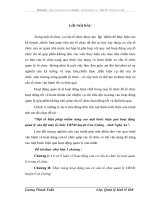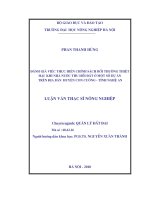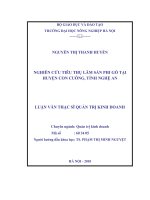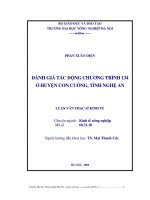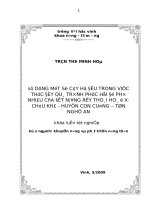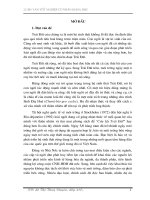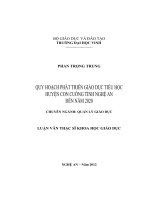Developing community – Based tourism in Con Cuong district, Nghe An province
Bạn đang xem bản rút gọn của tài liệu. Xem và tải ngay bản đầy đủ của tài liệu tại đây (977.45 KB, 10 trang )
HNUE JOURNAL OF SCIENCE
DOI: 10.18173/2354-1067.2019-0074
Social Sciences, 2019, Volume 64, Issue 11, pp. 135-144
This paper is available online at
DEVELOPING COMMUNITY – BASED TOURISM
IN CON CUONG DISTRICT, NGHE AN PROVINCE
Hoang Phan Hai Yen
Institute of Social Education, Vinh University
Abstract. Community-based tourism (CBT) is now considered as a beneficial type
for local sustainable economic development. CBT not only helps local residents
protect Eco-environment resources but also offer chances to preserve and promote
unique cultural features of the locality. Some provinces of Vietnam have developed
successfully CBT in mountainous areas with many ethnic minorities such as Lao
Cai, Ha Giang etc. This type of tourism has brought practical effects which not
only promote the strengths of indigenous culture of ethnic groups, but also
contribute to poverty reduction and improve the lives of many local people. The
study focuses on analyzing the situation, thereby proposing some feasible solutions
to develop community based tourism in Con Cuong district, Nghe An province.
Keywords: Tourism, community-based tourism, Con Cuong district, Nghe An
province.
1.
Introduction
CBT is defined in Law on Tourism 2017 (taken effect from January 01, 2018), as “a
form of tourism that is developed on the basis of community’s cultural values managed,
used and benefited by a local community”.
In the world, there have been many studies on CBT. In 2003, in the study Tourism in
Destination Communities (CABI), Shalini Singh, Dallen J. Timothy & Ross K. Dowling
mentioned the impacts of tourism activities on three aspects of destinations including:
natural, cultural, social, and economic environments as well as the relationships between
tourism and destination communities. In addition, the authors also emphasized the impacts
of tourism on destination communities, thereby pointed out the opportunities and
challenges for destination communities in tourism development [2].
In 2006, in the research on Community Development through Tourism (Landlinks),
Sue Beeton provided a basic system of tourism theory and community-related issues in
tourism development through effective combination between community planning,
business planning and tourism planning [3].
Etsuko Okazaki (2008), Kobe University published the research project: A Community
Received July 17, 2019. Revised September 5, 2019. Accepted October 2, 2019.
Contact Hoang Phan Hai Yen, e-mail address:
135
Hoang Phan Hai Yen
-based Tourism Model: Its conception and Use in which proposed a model of communitybased tourism based on the synthesis of a basic system of community theory, community
participation, and community-based tourism. Especially, the author referred to the theory
of social capital in the research in order to apply theoretical models to real-world situations
in Palawan, Philippines [4].
In spite of also researching on CBT, Liedewij van Breugel (2013) focused on
researching the participation of community members in tourism projects, analyzing the
relationship between participation and satisfaction of communities through results of
tourism by case-studies with communities, namely Mae La Na and Koh Yao Noi in
Thailand (Community-based 6 Tourism: Local Participation and Perceived Impacts, a
Comparative Study between two Communities in Thailand) [5].
In general, such researches on CBT and community-based tourism development
mainly directed at the disadvantaged community groups of destinations with a great
attraction from values of tourism resources. These researches have pointed out the
advantages as well as difficulties in developing CBT through the research and assessment
of tourism resources of destinations in association with local community factors; have
studied the impacts of awareness and attitudes of communities on tourism development or
have studied the involvement of local communities in tourism activities and impacts o
CBT on all aspects of local life.
Con Cuong is a mountainous district located in the western part of Nghe An province.
This is a highland district with favorable geographical location and conditions for
developing agriculture, forestry and tourism. The district has been included by UNESCO
in the list of sites in the Western biosphere reserve in Nghe An and Con Cuong provinces
as the core of the reserve, with the center being Pu Mat National Park.
Although this is a poor district of the country with a huge number of ethnic minorities,
Con Cuong has made a new breakthrough in the strategy of socio-economic development
and district economic restructuring thanks to the efforts of the entire district as well as
attention of the central and local authorities Economic sectors that need to be invested are
agriculture, forestry, trade and tourism. In particular, CBT in association with the
advantages of resources, people and customs of ethnic minorities has really become an
important highlight in the district's economic picture.
Despite the district has gained positive results in the development of communitybased tourism, the income of people doing community based tourism depends on tour
operators and guiders. This results from small-scaled activities in a spontaneous and
unprofessional manner, badly-organized investment and no specific support mechanism
from its competent authorities.
2.
Content
2.1 Data and research methods
2.1.1. Data
The data is calculated and analyzed from sources such as: Statistical Yearbook of
Nghe An Statistical Office, reports of the People's Committee of Nghe An province,
Department of Tourism of Nghe An province, People's Committee of Con Cuong
district. Primary data are collected and then processed, calculated and summarized into
136
Developing Community-Based Tourism in Con Cuong district, Nghe An province
tables for comparison, comment and analysis. All data in the period of 2010-2018 are
collected and survey results are conducted in 2019.
2.1.2. Research Methods
The paper combined following methods such as: data collection, analysis, synthesis
and comparison. In particular, the author uses two main methods:
- Investigation: Using the questionnaire to directly survey 40 households in 04
villages, such as: Khe Ran (Bong Khe commune), Nua and Pha villages (Yen Khe
commune), Xieng village (Mon Son commune) of Con Cuong district regarding the
situation of community based tourism, assets and income of households which engage
in CBT, advantages and difficulties in CBT development, local residents’ proposal, etc.
- Managerial consultation: This method is performed by interviewing with the
President of the People's Committee of Con Cuong district, the Head of the Industry and
Trade Department, the Head of the Culture Department, the Head of Labor, Invalids and
Social Affairs, the Head of the Agriculture and Head of 04 villages in Con Cuong
district. The total number of interviewed managers is 10. The interview content is
mainly related to: Strategies and policies for CBT development, challenges for CBT
development and current and future CBT development solutions.
2.2 Research results
2.2.1. The main advantages of Con Cuong district in terms of CBT development
Con Cuong district is located in the southwest of Nghe An province, 130 km far
from Vinh city. II borders with Quy Chau district to the north, with the Lao People's
Democratic Republic to the South, with Tuong Duong district to the southwest, with
two districts of Anh Son and Quy Hop to the east. In 2017, the district has an area of
1,738.08 km2, a population of 71,126 people, accounting for 10,5% of the area and
nearly 2,3% of the population of Nghe An province.
2.2.1.1. Natural conditions and natural resources
Con Cuong is located in the North Central climate sub-region featured by monsoon
tropical with two seasons: hot season (heavy rain) from April to October and cold
season (little rain) from November to March of the following year, and two transition
seasons. The summer is strongly influenced by the southwestern monsoon winds that
are very dry and hot, the winter is influenced by the cold northeast monsoon with
drizzle. Con Cuong is also directly affected by the mountains of southwestern Nghe An,
so it has its own characteristics of weather elements. Cold and dry weather often occurs
early and lasts long.
Con Cuong has a dense river system with a density of about 4-6 km/km2. Due to the
heavy rainfall, its rivers and streams have plentiful water resources and steep terrain
with high potential. Ca river is the largest river flowing through the district (with the
length of 30 km through the territory of the district). The river has many waterfalls,
rapids, streams and streams located among the mountains. Tributary system in both
sides of Ca river including Khe Choang, Khe Thoi, Khe Vang, Khe Chai, Huoi Co,
Huoi Lac, Khe Cong, Khe Xoang, Khe Don, Khe Co, Khe Met, Khe Hien, Khe Hoi, etc.
forms the fish-bone network of rivers and streams. Especially, Giang River originating
from the Truong Son mountain range as a vertical line, irrigating the fields in Mon Son
137
Hoang Phan Hai Yen
provides water and embellishes the natural picture for Con Cuong with more lines and
vividness.
As a mountainous district, Con Cuong has a large potential of forests; its forestry
land area in 2017 was 161,2 thousand hectares, accounting for 88,65% of the total
natural land area. With the forest cover of 80%, its forests have nearly 12 million m3 of
timber, over 140 million corks, bamboos and many precious woods such as Po Mu, Sa
Mu, Tram, Lat Hoa, and Ken Ken. Animals include 64 species of mammals, 137 species
of birds, 25 species of amphibians, and 45 species of fish. In particular, there are many
species included in Vietnam's Red Book such as: Sao La, Langur, White-cheeked
Gibbon, Tiger, Gaur Con Cuong is rich in forest types, flora and fauna along with
natural beauty spots such as: Khe Kem waterfall, Bo Bo waterfall and 67 thousand
hectares of forest belonging to Pu Mat national park, more than 6 thousand hectares of
Pu Huong nature reserve.
All elements of natural conditions and natural resources give Con Cuong a beautiful
natural landscape like a majestic and lyrical painting. With mostly forest cover, Con
Cuong is like a green carpet. The low mountain ranges running from the northwest to
the southeast create a distinctive feature in the landscape division; among a number of
high peaks, the highest peak is Pu Mat (1,841 m), with species of Asian timber tropical
trees on the mountain, and year-round foggy condition, lower peaks including Pu Bon,
Pu Co Ca, Pu Quac, Pu Moc Coc, Pu Thanh, Pu Sa Giap, Pu Na, Pu Gai make the
powerful geographical division, and create the mystery for its mountain landscape.
Limestone blocks with specific forest types have disrupted the regularity of landscape
distribution in the Northwest - Southeast direction. The masses of mountains, caves,
limestone valleys such as Pha Tang, Pha Cau, Pha Kham, Pha Phay ... are located in the
center of the territory, distributed in parallel with Highway 7 and the Ca river have
highlighted in the landscape picture of Con Cuong district. This is a unique feature of
Con Cuong, unlike any mountainous district of Nghe An province.
2.2.1.2. Humanities resources
In 2017, the district's population was 71,126 people, accounting for 2,3% of Nghe
An province's population, population density of 46 people/km2. There are 09 ethnic
groups, including Thai (69,6%), Kinh (25,1%), Tho (4,8%), the remaining ethnic groups
account for only 0,5% including Kho Mu, Nung, Hoa, Tay, Mong, Dan Lai.
With nearly two thirds of the total population and unique cultural features, the Thai
community plays an extremely important role in preserving and promoting typical
cultural values in the biosphere reserve of Nghe An West area in general and Con
Cuong district in particular. Thai people have many unique cultural traits and many
preserved indigenous knowledge. Ethnic musical instruments such as percussion, gong,
drums, flute, trumpet, etc; Brocade fabrics and brocade fabric products; culinary
culture... are crystallized cultures over generations. The inclusion of unique cultural
identities in tourism development will contribute to improving the living standards of
the local people through conservation and service activities.
More particularly, Dan Lai is a ethnic group with about 3,000 people living in Con
Cuong district, mainly in the two villages of Co Giat and Bung. These villages in the
core zone of Pu Mat National Park are isolated from other villages. The Dan Lai ethnic
138
Developing Community-Based Tourism in Con Cuong district, Nghe An province
group has a different sleep sitting-up pattern compared to other ethnic minorities. This
practice is closely linked to the calamity suffered by their ancestors. Sleep sitting-up
was to be wary of wild beasts and the pursuing army officers (they might stand up to
run into the forest as soon as the army chased them). They often sit with their clasped
hands to hold their forehead, or put the indigo tree under the neck to sleep from fatigue,
or hold the end of the stick tightly to the forehead. Even in other activities such as
childbirth, “sitting” is also involved. Today, those strange customs have been
abandoned, the Dan Lai has also received the light of the external civilized world, but in
them still have the pristine, “primitive” beauty of their people. On December 19, 2006,
the Prime Minister of Vietnam approved a project on conservation and sustainable
development of Dan Lai ethnic minority currently living in the core area of Pu Mat
National Park, Con Cuong district, Nghe An , with a total budget of over 93 billion dong.
In terms of history and culture, according to the inventory results conducted by the
Management Board of Monuments and Landmarks in Nghe An province in late October
2015, Con Cuong currently has a total of 41 relics, landscapes and archaeological sites.
These relics and landscapes have distributed throughout the communes in the district,
especially in the communes of Yen Khe, Chi Khe, Bong Khe, Don Phuc, Luc Da and
Mon Son. Among these, there are many famous relics, landmarks and archaeological
sites such as Tham Hoi, Nang Man and Ma Nhai These relics combine with famous
places such as Pu Mat National Park, Giong River, and Moc stream and with unique
cultural identities of the Thai people and the Dan Lai people residing on the localities.
These are potentials for Con Cuong to develop community based eco-tourism.
The map of study area
139
Hoang Phan Hai Yen
2.2.2. Current situation of community tourism development in Con Cuong district
2.2.2.1. Tourist market
Thanks to support from project of Livelihood Diversification through Heritage
Tourism in Remote Agricultural and Fishery Villages by Jica (Japan), tourism activities
in general and CBT in particular in Con Cuong district have gained a clear and
prosperous step and attracted many households’ involvement. The number of visitors to
Con Cuong tends to increase, particularly in 2010, the whole district received only
11,543 visitors by 2018, increasing to 35,383 tourist arrivals and its average annual
growth rate of tourist arrivals of 15%/year.
Table 1. Results of tourism activities in Con Cuong in the period 2010 - 2018
No.
Criteria
Unit
2010
2015
2018
1
Total tourist arrivals
Arrival
11,543
16,292
35,383
1.1
International tourist
Arrival
241
548
1,083
- Over-night
Arrival
173
279
986
- Day-time
Arrival
68
269
97
Domestic visitor
Arrival
11,302
15,744
34,300
- Over-night
Arrival
6,836
10,715
17,680
- Day-time
Arrival
4,466
5,029
16,620
Number of room
Room
98
102
253
1.2
2
Source: Processed from [3], [4].
The majority of tourists to Con Cuong are mainly domestic tourists, accounting for
96.9% of total tourists. However, the number of international tourists has increased
rapidly; in 2018 there were 1,083 international tourist arrivals, an increase of 4.3 times
compared to that in 2010, the average annual growth rate is 20% / year.
In recent years, the large number of tourists mainly have visited Pu Mat National
Park, and then combined with visiting tourist sites in the buffer zone of the national
park. Therefore, in addition to eco-tourism development, CBT also has had favorable
conditions for rapid development.
Table 2. Results of CBT in Con Cuong in the period 2010 - 2018
No.
1
1.1
1.2
140
Criteria
Unit
2010
2015
2018
Total tourist arrivals
International tourist
Arrival
Arrival
1,092
164
6,430
247
10,072
1,077
- Over-night
Arrival
42
104
986
- Day-time
Arrival
122
143
91
Domestic visitor
Arrival
928
6,183
8,995
- Over-night
Arrival
23
542
4,650
- Day-time
Arrival
905
5,641
4,345
Developing Community-Based Tourism in Con Cuong district, Nghe An province
2
2.1
2.2
Number of stay facilities
Number
of
homestay
supported by the project
Number of local homestay
Facility
Facility
1
1
1
1
4
1
Facility
0
0
3
Source: Processed from [3], [4].
Con Cuong has initially attracted investment projects of tourism products and
services development funded by Muong Thanh Group, VSC Tourism Company. In
particular, the CBT model has continued to expand and develop. As of 2018, only Nua
village has 23 households and Pha village has 8 households engaging in CBT. The
number of tourists enjoying the community tourism experience is increasing; that
contributes to improving jobs and income for the local people.
Particularly, CBT activities in Con Cuong district has had a significant
development in terms of the total number of tourists, especially international visitors,
which has increased rapidly compared to 2015 (247 people), nearly 4.4 times.
2.2.2.2. Revenue from Tourism
Table 3. Revenue from CBT in Con Cuong district for the period of 2010-2018
No.
Criteria
Unit
2010
2015
2018
1
1.1
Revenue
Stay
Million dong
Million dong
354
45
645
84
1,943
220
1.2
Beverage
Million dong
205
376
1,007
1.3
Artistic performance
Million dong
56
92
521
1.4
Shopping
Million dong
48
93
195
%
2.5
3.4
6.9
2
Structure in revenue from
tourism of Con Cuong district
Source: Processed from [3], [4].
The constantly increasing revenue from CBT contributes to the overall economic
growth of the locality as well as encourages organizations and local people to step up
activities and diversify types of services in order to meet the increasing demands of
travelers. The achievements of local tourism have contributed greatly to the
implementation of the Resolution by the provincial Party Committee and the Con
Cuong district Party Committee on developing Con Cuong district into an eco-urban
area by 2020.
2.2.2.3. The impact of CBT activities on local residents
Through questionnaire of 40 households and 04 heads of villages Khe Ran (Bong
Khe commune), Nua and Pha villages (Yen Khe commune), Xieng village (Mon Son
commune) and 6 managers from the functional departments of Con Cuong district on
the impact of CBT, 100% of the respondents said that CBT development in Con Cuong
district has both positive and negative impacts.
With regard to benefits, CBT has provided employment opportunities for local
communities; facilitated local economic development through the sale of tourism
141
Hoang Phan Hai Yen
products and services (brocade products, bamboo and rattan products, agricultural
products, medicinal herbs, etc); contributed budget to tourism conservation and
development; supplied goods to local markets and services; and improved the image of
localities in the country and around the world.
In terms of drawbacks, CBT has also come with many risks such as increasing
living costs and land prices; disrupting the natural environment; increasing pollution,
waste, and noise; traffic congestion on festive seasons; high rate of crime; loss of
community identity and degraded cultural values.
2.2.3. General assessment
It is said that development of CBT model is the direction of many localities in the
Western region of Nghe An. Although this model is quite strange to many places, it is a
potential tourism one in poverty reduction and offering many benefits to the local
people in Con Cuong district. However, the current CBT development in Con Cuong
district is still inadequate. Although the number of visitors has increased, the length of
stay is quite short. Visitors mainly enjoy the cultural experience of cuisine, living habits,
watching and exchanging cultural and artistic activities with the local people but have
not used many other services in the community. Therefore, the spending of tourists is
still small; Moreover, the infrastructure, material and technical facilities as well as
tourism promotion are outdated, inconsistent and disconnected. At CBT places such as
Nua, Xieng and Khe Ran village, there is almost no tour guide; at present, VSC Tourism
Company in Con Cuong is initially implementing this item. This is a huge limitation in
travel services.
2.2.4. Some solutions to promote the development of CBT in Con Cuong district
2.2.4.1. Forming on-spot human resources for tourism
The main objective of developing CBT model in Con Cuong district is to create
more jobs and to transform the economic structure for the local people, to help people
develop tourism services in order to reduce poverty, Therefore, it is necessary to train
and employ local people. It should encourage local residents to promote their
friendliness, hospitality, and organize short-term training courses on tourism,
communication and foreign language skills for them.
2.2.4.2. Sharing economic benefits with the community through tourism revenue and job
creation for local residents
Direct economic benefit sharing is to deduct a part of tourism revenue to invest in
the local community. It should take a priority for investment in welfare works for the
community which has been mostly affected by tourism activities: Communes and
villages with roads toward tourist destinations and with quality of roads, production and
animal husbandry activities of the people affected directly by tourism activities. Such
works or investment items should be integrated with the purpose of environmental
protection such as hoardings, posters, sign boards, etc.
2.2.4.3. Improving sanitary and environmental conditions, limiting human impacts on
the local natural and ecological environment
Conservation of resources is one of the principles of community tourism
development, which is also a principle to ensure the sustainable development of tourism
142
Developing Community-Based Tourism in Con Cuong district, Nghe An province
activities in general and community based tourism activities in particular. In fact, most
of the households here throw waste in the area close to their homes, not having a waste
collection system that directly affects the environment. Therefore, the solution for
garbage collection and disposal proceeds as soon as possible to avoid negative impacts
on the environment.
2.2.4.4. Tourism promotion
CBT in Con Cuong district is a new model, so it is really necessary to apply
different forms of promotion and advertisement to introduce the destination.
- Building tours and routes, including information on: attractive tourist routes;
accommodation and beverage facilities including addresses and photos for travelers to
choose and contact.
- Promotion via the mass media: make promotional films to broadcast on TV
stations, produce articles, photos, report on newspapers, social networking sites...
2.2.4.5. Connecting with and supporting tour operators to take guests to the West Nghe
An region
Providing directly full information to tourism companies by means of promotion
such as brochures, newspapers, radio, television and publications. Among these, special
attention is paid to Internet media, social network like facebook, picasa, etc. On the
other hand, in order to solve the shortage of information, CBT sites must organize
Famtrip tours and invite tour operators to participate to introduce, promote and receive
their feedbacks on tourism products and services in the area.
2.2.4.6. Building and creating specific CBT products of each tourist destination
Tourism destinations should prioritize the construction of a number of typical
tourist products such as cycling in the village, new tourism products such as kayaking,
Zipline through the river of VSC travel company, or other products such as: Experience
for fishing, weaving, brocade weaving ... Building a booth to introduce local specialty
products, etc.; building a model of the village as a active museum for the local
community.
3.
Conclusions
It is affirmed that Con Cuong is a western district of Nghe An province with all
favorable conditions for CBT development. Although in recent years, the number of
tourists here has increased; its tourism activities are spontaneous and underdeveloped in
comparison with its inherent potential. Firstly, its tourism promotion is still limited.
Secondly, facilities and accommodation are temporary and insufficient; this is unable to
meet the conditions for meals, accommodation, sleeps, breaks for long-term stay guests.
Moreover, there is no close coordination among branches and industries in order to
create uniformity in tourism development. CBT development in Con Cuong in some
periods is still spontaneous. Therefore, the orientation of tourism development in
general and CBT in particular in Con Cuong district is necessary to preserve and
promote its outstanding natural and cultural values.
143
Hoang Phan Hai Yen
REFERENCES
[1] National Assembly of Socialist Republic of Vietnam, 2017. Law on Tourism. National
Politics Publisher
[2] Singh, S., Timothy, D. J., & Dowling, R. K., 2003. Tourism in Destination
Communities. United States: CABI Publishing.
[3] Beeton, S., 2006. Community development through tourism. Australia: Landlinks
Press.
[4] Okazaki, E., 2008. “A Community-based Tourism Model: Its conception and Use”
Journal of Sustainable Tourism, 16(5), 511-529.
[5] Breugel, L. V., 2013. Community-based Tourism: Local Participation and Perceived
Impacts, a Comparative Study between two Communities in Thailand. (Master Thesis),
Radboud University Nijmegen, Netherlands.
[6] Statistics Office of Con Cuong district, 2018. Statistical Yearbook of Con Cuong
district in 2017. Nghe An Publisher.
[7] Con Cuong district PC, 2019. General Report on Tourism Development of Con Cuong
district in the period of 2010-2018.
[8] Vinh Dau Quang, 2019. Constructing Community based tourism models in line with
hunger eradication & poverty reduction. Provincial Project.
144

